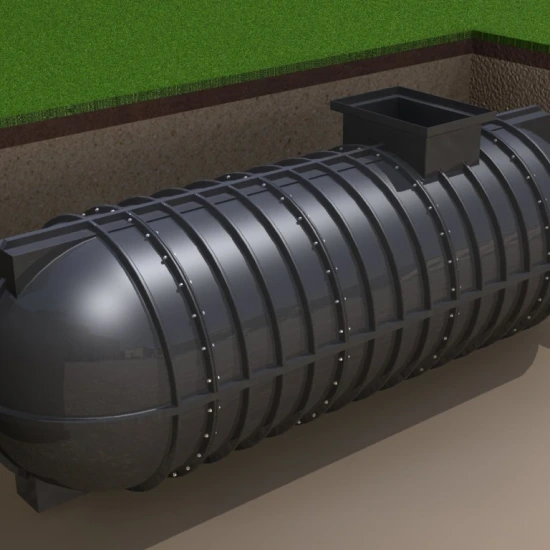Tanks can be used buried in the ground. These types of tanks are built underground and are typically made of polyethylene. These tanks are called underground water storage tanks. They are used in many areas and provide a sense of security to their users because the contents stored inside them cannot easily be stolen. Buried tanks can be used for the following purposes:
1- Agricultural Irrigation
Buried tanks can be used in farms, gardens, golf courses, parks, and other areas. These tanks refer to structures used for storing agricultural products. Products such as grain, corn, soybeans, and oats can be stored in tanks. During storage, the humidity level, temperature, and air conditions are controlled to minimize spoilage and preserve the quality of the stored products. In addition, modern storage facilities can also perform operations such as sorting, packaging, labeling, and tracking of the products, making it easier to track the products. Tanks can also be used for other purposes in agriculture, such as storing animals in sheds or slaughterhouses. They can also be used to return excess water to the ground. These storage systems contribute to water management and encourage the renewal of natural water sources.
2- Emergency Use
Storing water to meet the water needs in case of emergency. These tanks can be pre-prepared for emergency situations. Buried tanks are an option for storing agricultural products during emergencies. This type of storage allows products to be stored under natural conditions and remain unaffected by various natural disasters, such as floods or storms. It also allows the humidity and temperature of the products to remain naturally balanced, minimizing spoilage.
Buried tanks for emergencies can be especially useful in situations such as regional disasters or food shortages. For example, underground storage systems allow products to be safely and long-term stored, reducing the risk of spoilage during storage. These types of storage systems have been used since ancient times but are still only used at a primitive level in some areas, especially in dry and sparsely populated areas. Tanks made using modern technologies, especially those with heating/cooling systems, are considered less risky.
3- Fuel Oil Storage
Buried storage facilities are generally used for the storage of agricultural products. However, this type of storage system can also be used for the storage of other materials. For example, buried storage facilities can be used for the storage of fuel oil, gasoline, and other derivatives.
Special pipes designed for fuel oil and other derivatives are used in these types of storage. These pipes are installed underground and are used for pumping petroleum products when needed. Plastic vertical water tanks can also be used for fuel oil storage. Because fuel oil is a valuable substance, storage products located underground are preferred to prevent theft.
Buried storage systems provide a safer way to store petroleum products. For example, storing underground reduces the impact of external factors on petroleum products. At the same time, storing underground minimizes the possibility of petroleum products causing damage to the environment in the event of a possible leakage. However, obtaining legal permits and approvals from environmental authorities is necessary for this type of storage, and taking necessary precautions for safe and effective storage is also important.
4- Use in Rainwater Harvesting Systems
It is used for storing drinking water. These types of tanks can be specifically installed for homes or businesses, with on-site installation options available. Buried storage facilities can be used in rainwater harvesting systems. These types of tanks can be used as rainwater collection systems, or for filtration, purification, or storage of rainwater. When buried storage facilities are used for rainwater harvesting, they can be used for the filtration, purification, or storage of rainwater. In particular, the temperature and humidity levels underground enable rainwater to be stored for a longer period.
Underground rainwater tanks can also be used to eliminate problems caused by rainwater on the surface. For example, they can be used to prevent waterlogging in residential or agricultural areas caused by rainfall. However, preliminary research, design, and compliance testing are necessary for this type of storage. Taking necessary precautions for safe and effective storage is also important.
The buried nature of underground storage facilities makes them less visually disturbing and reduces their environmental impact. However, installation of these types of tanks can be more difficult and costly, often requires professional support. The capacity and material of buried tanks are chosen according to the settlement and purpose of water use.


 EN
EN
 DE
DE
 FR
FR
 IT
IT
 ES
ES
 PT
PT
 RU
RU
 AR
AR
 BG
BG
 SR
SR
 GR
GR
 SQ
SQ
 RO
RO
 PL
PL
 HU
HU
 CZ
CZ
 HR
HR
 AZ
AZ
 GE
GE
 AM
AM
 IL
IL
